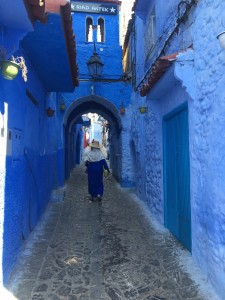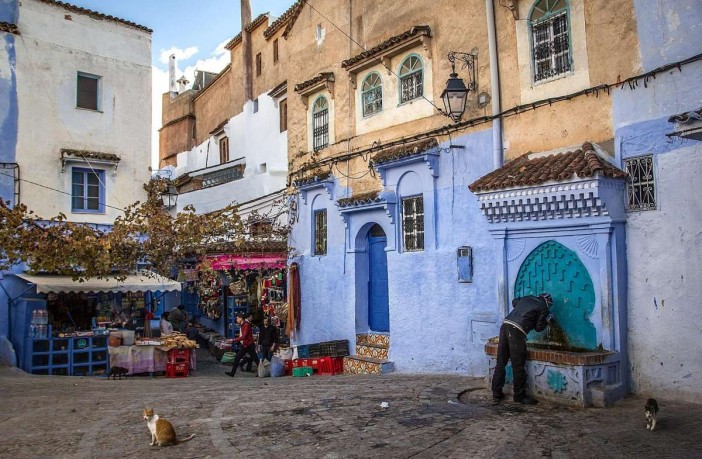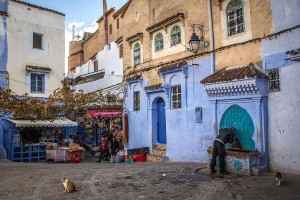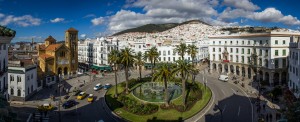The Straits Times
The city of Tangier (above) boasts both the ancient, such as the old walls of the medina (left), and the modern, in the form of new construction projects in the main city district. The city of Tetouan (far left) in northern Morocco and a souk (left)
The town’s water comes from the surrounding mountains and tastes subtly sweet.PHOTOS: GURVEEN KAUR, MOROCCAN TOURISM BOARD
Mountains meet the sea in the Moroccan city of Chefchaouen, where the buildings are painted blue, while history comes alive in Tetouan and modernity sneaks up on Tangier.
I have stepped into an all-blue realm inside Morocco.
The walls, doors and even window grilles of houses in the medina, or ancient quarters, of Chefchaouen are awash in vivid shades of azure, cornflower blue and cyan.
The soothing palette runs across staircases, narrow pathways, central squares and even flower pots.

A few steps ahead is a diminutive figure, cloaked like a wizard, waiting for me, aware that I will get lost in the silent, labyrinthine lanes.
Drenched in blue, Chefchaouen (pronounced shef-sha-wehn) is like a beautiful illusion.
The ancient quarters of Chefchaouen are awash in shades of azure, cyan and cornflower blue.
Yet Chaouen, as the locals call it, has been continuously inhabited since it was founded in 1471.
It has an otherworldly allure, which I also discover in two neighbouring cities, Tetouan and Tangier, during a five-day trip to northern Morocco.
Each town offers a portal into the mysterious past through the medina, a significant microcosm of Moroccan life.
A hop, skip and a jump away from Spain, there might be no iconic Sahara Desert in this part of the African continent, but it is rich in other natural wonders and European influences.
Bordered by the Atlantic Ocean and Mediterranean Sea, northern Morocco is also home to the Rif Mountains, a gargantuan chain of rolling ranges I encounter each time I travel between the three cities.
My starting point is the luxurious Banyan Tree Tamouda Bay (www.banyantree.com) in Fnideq, a seaside town popular with wealthy Moroccans in the summer – akin to the Hamptons in the United States.
Launched in September last year, the resort is the home-grown Banyan Tree hospitality brand’s first outpost in Africa and Morocco’s first all-pool villa resort where all 92 villas come with a private pool.
Any prior wish to stay in a riad (traditional Moroccan house) for an authentic experience is forgotten the moment I step into my spacious villa. It is an opulent space with Moorish and Andalusian touches paying homage to its surroundings.
The city of Tetouan (above) in northern Morocco and a souk withstalls selling fresh produce and more. PHOTOS: GURVEEN KAUR, MOROCCAN TOURISM BOARD
I try out a hammam or bathhouse experience – a routine among Moroccans who visit public hammams – as part of the resort’s signature Rainforest Indulgence spa treatment, and leave the room feeling cleaner than I have ever been before.
As I lie naked across a marble slab, the sweet-looking masseuse vigorously scrubs every part of my body. I am reduced to being a helpless child who has spent too much time jumping around in mud and is now being purified at the mother of all baths.
From the resort, when we embark on a 11/2-hour drive to Chefchaouen for a day trip, I spy endless rows of palm trees lining the sparkling clean roads.
Security on the roads is tight and we are regularly stopped by the police as the area is in such close proximity to Europe.
There are existing concerns of illegal immigration: Africans have sought to enter Europe through Spain, and Morocco is its closest African neighbour.
Nature is never too far away here. There are many glimpses of the sea as we drive through the Rif Mountains, home to villagers including the Berbers, the original inhabitants of the country from as far back as 4BC.
We come across a pair of Berber women, easily recognisable by the red-striped “fouta” – or piece of cotton cloth worn sarong-style across their waists – as we stop to take photos of the landscape.
CHEFCHAOUEN: BLUE BEAUTY, PURE LIFE
We meet our guide for the blue city, Mr Ahmed Achtot, 62, who is wearing a pale yellow djellaba (traditional loose-fitting outer robe with a distinctive conical hood) and a red tarboosh (a hat shaped like a truncated cone with a tassel).
A resident of Chefchaouen all his life, Mr Ahmed takes one look at this city slicker and says the people here live a “pure life”, free of work stress.
Within the medina, its serene residents walk everywhere, including up steep staircases and slopes.
I notice a significant elderly population here as they slowly go about their business, oblivious to curious tourists.
GETTING THERE
There is no direct flight from Singapore to Tangier, Tetouan or Chefchaouen in northern Morocco.
Fly Qatar Airways (www.qatarairways.com) to the neighbouring Moroccan cities of Casablanca or Marrakech, then transfer to a domestic flight to Tangier or Tetouan. Chefchaouen does not have an airport.
Alternatively, after flying to the airports of Casablanca or Marrakech, catch a train, taxi or bus to the three northern cities.
WHERE TO STAY
The resort Banyan Tree Tamouda Bay (www.banyantree.com/en/em-morocco-tamouda-bay) is located less than two hours by car from Tangier, Tetouan or Chefchaouen.
It can organise tours to this trio of cities plus the Spanish enclave of Ceuta. It also arranges recreational activities such as scuba diving, biking and crafts for children at its Kids Club.
Banyan Tree, which opened in September last year, has 92 luxury villas with a private pool each. Villa rates start at 4,260 Moroccan dirham (S$604) for the Bliss Pool Villa, which has a king-size bed and a spacious living room.
TIPS
• The best time to visit the northern part of Morocco is spring (mid-March to May) and autumn (September to October).
Try to avoid summer as that is when Europeans travel to Morocco and the locals also head to the cooler north.
• Money-changers in Singapore do not supply Moroccan dirham so it is best to convert Singapore dollars into US dollars, euro or British pounds, which can be exchanged for dirham when you arrive in Morocco. Cash is the preferred method of payment across the country. Before leaving Morocco, exchange remaining dirham for US dollars, euros or pounds.
• Unlike in Tangier, the residents of Tetouan and Chefchaouen dress conservatively. Female travellers are advised to wear loose clothing that are not too revealing and to carry along a scarf, in case there is a need to cover up further.
WHAT TO EAT
The cuisine of northern Morocco is hearty and bursting with flavour. A traditional meal is well-balanced, with healthy portions of vegetables and meats or seafood dressed with a blend of aromatic spices.
Moroccan mint tea
Upon touching down, travellers will love a cup of soothing Moroccan mint tea. Made with green tea and mint leaves, it can be drunk at all hours of the day and is a good accompaniment with meals to aid digestion. It is customarily served in an elegant Moroccan metal teapot.
Tagine
This refers to both the distinctive cone-shaped casserole dish and the food that is prepared in it – a hearty slow-cooked stew.
The tagine dish has meat or fish and vegetables, all beautifully marinated in fragrant spices such as saffron, turmeric and paprika. The stew either sits atop a bed of fluffy cous cous – another Moroccan staple – or is served with Moroccan flat bread.
Make sure to mop up the remnants of the sauce at the bottom of the pan. That is where the most intense flavours lie.
Pastilla or b’stilla
Considered the north African nation’s version of a meat pie, the savoury flavours of the meat intermingle with the sweet dusting of icing sugar and cinnamon on the flaky filo pastry.
Pigeon meat is typically used, but chicken is a popular alternative. Along with the meat, the pastry is stuffed with almonds and onions.
Zaalouk
Pair the main course with zaalouk, a refreshing, summery salad of Mediterranean flavours: eggplant, tomatoes, garlic, olive oil and spices. It can be served hot or cold and is best scooped up with slices of flat bread.
I ask Mr Ahmed about the origin of the town’s colour and he says it is to keep flies away; the insects dislike clear, flowing water, which is how the blue-washed walls here presumably appear to them.
Not the most poetic answer, but after I do my own research online, I discover that there are other explanations too. One theory is that the idea came from the Jewish community, which had settled there in the 1930s. The colour mirrors the sky, with its allusion to divinity, hence bringing the Jews closer to God.
Look upwards and the top floors of buildings are in white, however, as the residents do not have ladders tall enough to reach that high.
I discover a hole-in-the-wall bakery where women send their kneaded dough daily to bloom into fluffy Moroccan flat bread that is eaten at almost every meal.
The town is a good place to look for souvenirs such as exquisite handwoven Berber rugs and straw hats adorned with colourful pom- poms.
The air is comfortably cool within the medina and the water is from the surrounding mountains. I drink straight from a hose randomly perched on a ledge and the water is subtly sweet.
As we prepare to depart, I notice an elderly man staring off into space with a smile. Surrounded by such beauty, I would be content too.
TETOUAN: MOORISH ALLURE, SOUKS GALORE
We move from blue to pristine white in Tetouan, a bigger city with more of a Moorish charm.
Early Berber dynasties and the Andalusians battled for control of Tetouan as it was destroyed and rebuilt before it became the capital of the Spanish protectorate of Morocco from 1912 to 1956.
What has emerged is a harmonious relationship among the Muslims, the biggest religious group in Morocco, and the Jews and Christians here.
Though the Jewish and Christian communities are minute today, there are still traces of them in Tetouan.
Look out for the stately Iglesia de Bacturia, the sole surviving Roman Catholic church built in 1926.
The streets are unmistakably busier in Tetouan than in Chefchaouen as we manoeuvre through the hectic roads to meet our guide Rashid, who is accompanied by a muscular and stoic man who does not say a word.
I learn that he is part of the tourist police force. I wonder if this is necessary as I have not been feeling unsafe – the Moroccan people I have met are courteous. But the locals must know better.
Along the way, I notice that the cafes lining the streets are packed with only men – no women – seated outdoors with their chairs arranged such that they face the road, an echo of European sidewalk cafes.
I feel watched and question Amine, the resort’s recreation supervisor who accompanies me on all day trips. He jests that they are there “to ogle at the ladies”.
We head into an important portal to Tetouan’s past – the medina, which is a Unesco World Heritage Site.
Filled with twisting alleyways with no end in sight, I am thankful for Rashid’s presence. One wrong turn and I will probably still be finding my way out.
Mountains of fruit and vegetables are placed on mats on the ground and piles of Moroccan bread greet me as we enter the souk or open-air marketplace. It is a cacophony of bargaining, heckling and chatter.
I gleefully spot a stall selling tagines, the conical earthernware pots in which Morocco’s most popular dish of the same name is stewed. A trip to Morocco would not be complete without a customary photo of these distinctive vessels.
There is plenty more to see as there are souks centred on non- food products too.
In one, locals peddle pre-loved items that range from wind-up toys to pagers.
At the back of a tannery that dates to the late 15th and early 16th centuries in the medina, Rashid points to three cemeteries in the distance. Each is linked to a different religion – Christianity, Islam and Judaism – and it is a poignant reminder that Muslim-dominated lands have tried to live harmoniously with minorities.
TANGIER: CAMEL RIDE, JUSTIN BIEBER
My final stop in northern Morocco is Tangier, an up-and-coming port city where Africa’s first high-speed rail is being built.
Fought over by the Moroccans, British, French, Portuguese and Spanish, Tangier has a chequered past.
A popular getaway for artists and writers such as Matisse and Truman Capote in the early to mid-20th century, the appeal of this rising city lies in its contrasts of old and new.
Cranes sprout high in the sky and, in the main city district, most Moroccans are dressed in Western clothes.
We first make a pit stop at one of the most popular attractions in Tangier, the Caves of Hercules, located about 14km outside the city.
The forces of nature have carved an opening in the cave that looks like the map of Africa. A wondrous sight, but perhaps not worth the detour if you have only a day in the city.
Do look out, however, for the camels resting incongruously on the beach. It may not be the Sahara Desert, but where else will one get to ride a grumpy camel by the Atlantic Ocean?
After checking the camel ride off my bucket list, we make our way to the old walled city of Tangier, with its quiet cobbled lanes and architecture with touches of European influence.
There are plenty of physical reminders of the past here as I regard the weathered bricks and peeled paint and imagine the city’s storied past.
I meekly interrupt a group of boys playing marbles as I walk between them. A few hundred metres ahead, we encounter another group of older teenage boys listening to the latest Justin Bieber hit on a smartphone.
A jolt to my senses, the contemporary song is out of sync with this ancient enclave.
Yet, this odd modern moment is of minor consequence in a country where remnants of the past are so treasured.
•The writer’s trip was hosted by Banyan Tree Hotels & Resorts and Qatar Airways.










